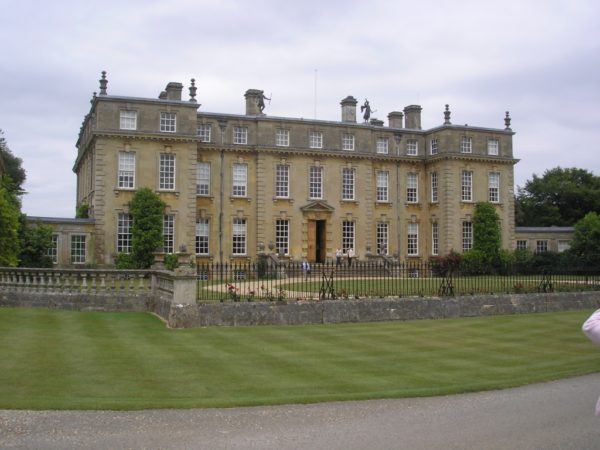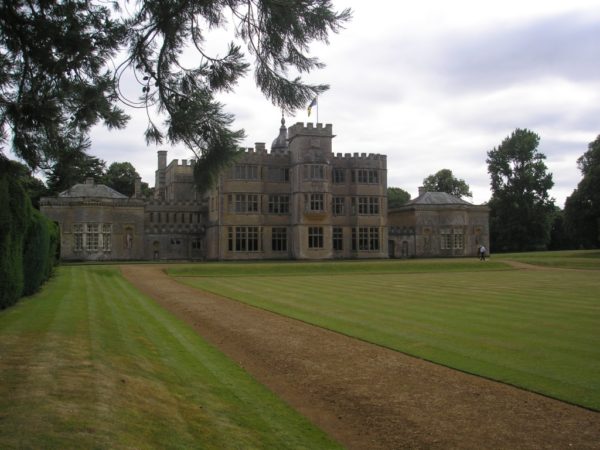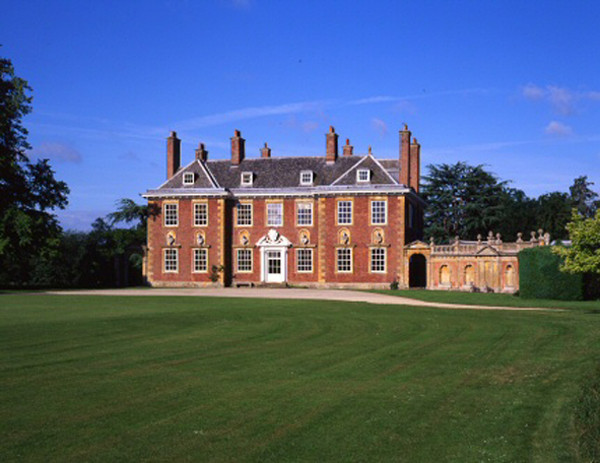- Our three day visit to Warwickshire and Oxfordshire was organised by Tony Mills and James Lomax and was based at the comfortable Charingworth Manor Hotel near Chipping Campden.
-
Ragley has a long history of alternating activity and atrophy. The Robert Hooke house of the 1680s was never completed as planned, was continued by the elderly James Gibbs in the 1750s and finished by James Wyatt in the last years of the century and beginning of the 19th. Very little happened after the great days of the Regency when the Prince was an intimate friend of the 2nd Marchioness of Hertford. Its serious decline dates from 1870 when the inheritance was split after the death of the 4th Marquess with all his unentailed property going to his illegitimate son Sir Richard Wallace. It was saved from total dereliction by the heroic restorations of the 8th Marquess from the 1950s onwards.
There is little information available about the furnishings, either because of the loss of the archives or lack of research. However, it is known that the 1st Marquess spent over £654 with William Vile in the late 1750s/early 1760s soon after the James Gibbs’ work was finished, and that the 2nd Marchioness and her mother were clients of Chippendale junior at Temple Newsam. In addition, a fine pair of bombe-fronted coromandel commodes attributed to Pierre Langlois was on the market recently, so we were on the look-out for a chinoiserie theme as well as pieces from these makers or epochs.
The Great Hall is one of the most memorable and grand English rococo interiors, with its festive plasterwork incorporating figures of Britannia in the ceiling and Peace and War in the centre of the long walls, brackets, busts, vases, festoons and drops, all the work of James Gibbs’ Italians including Giuseppe Artari shortly before he re-located to Schloss Bruhl to work for the Archbishop-Elector. The furniture includes its original suite of grained hall seats and benches, decorated with pierced backs and painted heraldry, but also with strangely gothick blind fretwork on the rails. Their robust coarseness surely precludes their execution being metropolitan. There was a Regency boulle centre table in the style of Bullock, presumably reflecting the taste of the 2nd Marchioness. Next door, the Music Room had the first pieces from a long set of chairs and sofas known here as the Trafalgar suite and indeed dating from c1805. They are strongly reminiscent of Henry Holland’s furniture for Southill but here are japanned in black and gold. They could conceivably be by Chippendale junior for the 2nd Marchioness. Here were also the first two tall tapering pedestals from a set of at least eight, beautifully carved with combined Palladian and naturalistic ornament, almost certainly by Vile, now sadly caked in layers of paint. Perhaps they were originally intended for holding either sculptures or portable lighting devices.
The main feature of the Breakfast Room was the charming rococo overmantel panel, carved with a hunting scene surmounted by a mask and a vase with festive garlands and flanked by dragon sconces. Nearby sat an incongruous Regency sideboard. The Dining Room table and two fine mid 18th century sideboard tables were clad with Regency and late 18th century plate, including a pair of egg shaped cup and covers by William Holmes 1776, and a set of four elaborate wine coolers with a royal duke’s armorials (possibly from the Duke of York’s sale 1827). Some of us were able to go over the ropes to view the exceptional French ormolu-clad bracket clock above the chimney.
The Wyatt-decorated Mauve Drawing Room contained a pair of extremely delicate green and grey japanned side chairs in the French style from a larger suite, probably from c1760. Also from the same date was a tall white and gold chimney mirror with fruiting branches and scrolls. A mahogany bureau secretaire with a Gothick lattice superstructure may be associated with the Vile commission. Nearby, a large rectangular roll-top desk with fine neo classical marquetry must date from the early Wyatt period of the 1780s. Similarly, in the adjoining Red Drawing Room were pieces from three different suites of English Louis XVI style seat furniture from this period, but also a set of three superb gilt rococo window cornices from c1760.
But perhaps the most thrilling pieces were to be found in the Green Drawing Room: a pair of soaring gilt chinoiserie glasses complete with little cottages, squarking ho-ho birds topped with an open pagoda with bells, overgrown with trees and foliage. These may have been the accompanying glasses to the displaced coromandel commodes mentioned earlier. Two fine mahogany chests of drawers stood between the windows and two elegant bonheurs de jours which could have been French or English in the French style stood in the middle of the room. Beside the chimney wall were two fine satinwood sidetables from c1790 with delicate classical marquetry, not dissimilar to examples by Chippendale junior in the Drawing Room at Paxton. The Prince Regent’s Bedroom contains the bed c1810 which he used on his periodic visits and the earlier hangings of painted Chinese silk, now in very poor condition.
Finally, in Graham Rust’s brilliantly decorated South Staircase Hall were a pair of x framed mahogany armchairs, probably part of a suite from c1760. But the coup de grace was undoubtedly another pair of brilliant rococo mirrors, the frames consisting of a controlled riot of scrolls and leaves cascading down from a free-standing shaped cartouche surmounted by a vase of flowers and enclosing an overflowing fountain. Thus we departed on a high note, delighted at the many surprises but wishing for answers to some of the questions which had been raised and that the house were better known and celebrated.
Ditchley Park
Our very knowledgeable guide at Ditchley was the retired Bursar who provided us with a wealth of information about the great house and its occupants. The relative contribution of the different architects involved appears still a matter of debate: James Gibbs, Francis Smith of Warwick, William Kent or Henry Flitcroft. The craftsmen were the finest the early 18th century could produce: with the plasterers Artari, Vassalli, Serena and William Roberts of Oxford; and Henry Cheere for chimneys. William Hallett, James Moore and especially William Bradshaw are all recorded as having been involved at Ditchley but nothing of theirs has survived in situ.
Built for the 2nd Earl of Litchfield the Hall and family rooms were completed in the mid to late 1720s, and the State Rooms after a pause in the 1730s. His heirs were the Jacobite-Franco-Irish Viscounts Dillon who were often abroad. The house was sold to Ronald and Nancy Tree in 1933 after the tapestries and pictures had been dispersed. Their period saw a new golden age for the house, particularly during World War II. After their departure the house was bought by the Earl of Wilton who sold much of the surviving original furniture. It was then acquired by Sir David Wills who endowed it as the Anglo-American conference centre. Thus, although much of the original furniture has gone, there have been many subsequent additions (and high class reproductions) which make this a house of the greatest interest, not least the large number of furnishings acquired from the Beningborough sale in 1957 (many of them, in turn, once at Hampton Court, Herefordshire).
The Great Hall was restored in 2006 and surely vies with Houghton and Holkham among the finest of the early 18th: the theme is set by William Kent’s ceiling of the Assembly of the Gods with the two large pictures from the Aeneid; busts of the poets sit on garlanded brackets while the Liberal Arts look on from the pediments. Fortunately the Kent/Flitcroft furniture here is intact and provides some of the earliest purely ‘Palladian’ furniture to be found anywhere, notably the table opposite the chimney attributed to a James Roberts and the set of four benches. Above them are four of the original six glazed wall sconces/lanterns suspended by chains from lion masks.
From here we proceeded through the (former) Tapestry Room (with a fine walnut secretaire), to the Velvet Room, clad with its original crimson and yellow velvet and satin wall hangings apparently depicting the Indian goddess Siva, supplied from Genoa in 1738 and which also hung on the State Bed in this room. A great rarity was the walnut jewel or toilet casket of Anne Hyde, James II’s first wife, clad with silver (? French or Dutch ) mounts at the corners and in the centre with armorials and coronets en accollee (not dissimilar to the Lennoxlove toilet service). After a small corner closet we entered the White Drawing Room, originally the dining room or Great Room, with its full length family portraits in fine Palladian frames and a pair of side tables with eagles ‘displayed’ which fit well and were gifts from Ronald Tree from Mereworth. They perhaps occupy the space where the two ‘Hercules’ side tables now at Temple Newsam once stood. In the Green Silk Room beyond was a rare black scagliola table top, apparently unsigned. Finally on the ground floor the Saloon was in contrast to all the other interiors in being entirely Baroque in style, the work of Gibbs and his Italians: the plasterwork and ornament suggestive of contemporary European decoration and owing far more to Borromini than Palladio. Upstairs many of the bedrooms retain their original (or replicated) decorative schemes from Nancy Tree’s regime: idiosyncratic pale colours, plain carpets and needlework rugs, festive chintzes and papers, with bathrooms and furniture arranged for total comfort. It is the very birthplace of the super-English ‘country house look’, a classic style which spread throughout the entire anglophone world via her interior decorating business at Colefax and Fowler.
Rousham Park
It was a pity that the principal guide at Rousham seemed unwilling to give detailed answers to our questions and appeared to be largely indifferent to our interest. Perhaps this only increased our speculation and encourages us to seek further information elsewhere. The Dormer’s H plan Caroline house was altered and extended for the bachelor General James Dormer by William Kent between 1738 and 1741, creating a battlemented profile with an ogee cupola and two new wings containing the Painted Parlour and a Library (now the Great Parlour). Kent was responsible of a number of inventive chimneys, overmantels and other furnishings. His presence certainly permeates the house and is felt even among the antiquarian furnishings of the Great Hall: a set of parcel gilt pedestals and brackets for the General’s ubiquitous collection of bronzes after the antique, and a set of cabriole-legged upholstered armchairs with Vitruvian scroll rails. In the Drawing Room upstairs there were some remarkable and unexplained Nymphenburg porcelain figure groups and there was much discussion over a single elegant French-style open armchair, japanned in white and green and reminiscent of the models at Dumfries House and Nostell. It had elements of Chippendale’s style about it including a vertical back post and distinctive scrolled foot terminals. Chippendale is known to have supplied furniture to the value of £14-14-6d to the General’s successor, Sir Charles Cottrell-Dormer, but this is usually associated with the marble-topped sideboard table in the Dining Room, following a pattern from the Director, but enriched with vine trailing ornament in the frieze which follows exactly the same motif on the frames of the murals which are attributed to Thomas Roberts of Oxford. Perhaps this was a case of an outsider being brought in to enliven an otherwise somewhat dull piece of furniture.
In the relatively small and low ceilinged Painted Parlour the great feature is Kent’s grotesque ceiling painting and the strong Palladian features of the decoration and joinery including the chimney, doorcases, brackets (for more bronzes), mirror and furnishings. Here was the first in a long suite of upholstered arm and side chairs in parcel gilt mahogany with a Vitruvian scroll motif on the rails executed this time in braid against a green silk ground which may be original. The legs and arm supports are decorated with pendant leaves picked out in gold in relief. They are part of an interesting family of similar designed chairs found at Holkham, Alnwick and formerly at Wroxton Abbey among other places. One grand gilt side table with a carved mask on the apron supported a scagliola top, while a second table echoed the parcel gilt suite of chairs. Nearby in the Music Room were two bureaux, each apparently bearing makers’ labels: one for Coxed and Wooster (in their characteristic style), and the other by Prichard. The Passage leading to the Great Parlour contained a fine late 17th century lacquer cabinet which was supported somewhat incongruously on a gilt Palladian frame. The Great Parlour was remodelled out of the General’s Library in the 1760s for his successor Sir Charles Cottrell-Dormer but retains Kent’s idiosyncratic vaulted ceiling and chimney. Thomas Roberts of Oxford provided the breathtaking rococo plasterwork frames which surround the full length portraits and carved the pierced decorative doorcase cornices. In addition to more of the parcel-gilt armchairs and side chairs described earlier there was a series of cabriole-legged fan-back side chairs with yet more Vitruvian scroll rails, a variation of the upholstered armchairs we had seen in the Great Hall.
The landscape at Rousham is one of the glories of the early Picturesque movement, laid out by Kent who was building on Charles Bridgeman’s earlier work. Many of us took the opportunity to walk through the wooded glades to Venus’ Vale with its ponds and cascades, then following the serpentine rill to the clearing beside the Temple and statue of Antinous with the eyecatchers beyond, and back via the Praeneste and Pyramid to the delightful walled garden, pausing to sit on one of the two Kent-designed garden seats to rest and admire the scene.
Honington Hall
We were greeted at Honington by the owner Sir Benjamin Wiggin who proved to be a most engaging and informative guide to his wonderful home. In the Wren-inspired church beside the house, with its fine joinery, he told us of the history and vicissitudes of the house, not least his and his father’s valiant and successful work in saving the house from rot and dereliction. The classic 1680s house was partly remodelled in the 1740s and 50s for Joseph Townsend. Entering the Hall one is met with an overpowering repertory of rococo plasterwork enhancing an underlying Palladian framework. It is attributed to the talented but elusive Anglo-Dane Charles Stanley: large reliefs from the Aeneid again, with smaller ones of the Seasons above the doors and figures of the Elements in the ceiling. Next to it, in the panelled Oak Room, was one of the two magnificent pedimented glasses original to the house, facing its twin between the windows in the Boudoir beyond.
From here we entered the climax of the house, the domed octagonal Saloon, added to the existing house and designed by the amateur architect John Freeman in the early 1750s and executed by William James, the architect of the Ranelagh Rotunda. Its strong architectural features are completely softened and almost annihilated by the wealth of rococo plasterwork. In the vault all 96 rosettes are different, all apparently in swirling motion, giving a sparkling quilted effect, while the ribs have eight cascading rococo trophies with leafy scrolling cartouches containing figures and emblems. These are echoed in the angles of the walls below, with emblems of the Seasons and the Elements, augmented by bunches of flowers and fruits and all coming to rest above asymmetric wall brackets (for branched candelabra) whose rococo character defies description but are reminiscent of similar examples in white porcelain. Two immense glasses, even more elaborately ornamented, if it were possible, face the windows onto the garden and continue this playfully ironic theme of theme of ‘nature’ triumphant over ‘art’. With a colour scheme of delicate sky-blues, off-whites and gold, perhaps here we have the nearest the English ever came to creating an Amalienburg: Der Rozenkavalier in Warwickshire. Who says the English don’t do rococo ? The work is bold and confident, on a bigger scale and in an altogether different hand to the artist of the Hall – who was he ?



